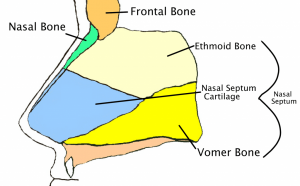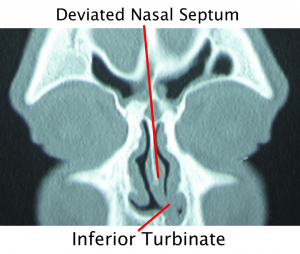Your path to breathing better begins here: Solve your deviated septum issue
Living in SoHo and struggling with blocked or uneven nasal airflow can often be the result of a deviated septum, a condition in which the cartilage and bone dividing the nasal passages is shifted out of proper alignment. This can create breathing difficulties, sleep disturbances, and other related issues. Dr. Mourad is highly experienced in diagnosing these conditions and performing deviated septum surgery, known as septoplasty, to correct the alignment. Patients in SoHo who undergo this procedure benefit from improved breathing, enhanced comfort, and a noticeable improvement in the overall function of their nasal passages.
Relieve your breathing problems with septoplasty in SoHo – Meet with Dr. Mourad
Septoplasty Procedure to Improve the Nasal Passages
Septoplasty is a corrective surgical procedure intended to resolve problems caused by a deviated septum and to improve the efficiency of airflow through the nasal passages. Typically performed on an outpatient basis, this surgery requires precise manipulation of the nasal structures, including reshaping or repositioning the cartilage and bone to restore proper nasal alignment. By addressing these structural challenges, septoplasty can reduce symptoms such as difficulty breathing, chronic congestion, and general nasal discomfort. The procedure provides patients with long-term improvement in nasal function while contributing to the overall structural integrity and comfort of the nose.

How Can Dr. Mourad Improve my Quality of Life with Deviated Septum Surgery?
Many SoHo residents who visit our practice have already tried various treatment methods, including nasal steroid sprays, antihistamines, or over-the-counter decongestants, but continue to struggle with breathing difficulties and nasal discomfort. We take the time to go over every available treatment option with our patients, providing detailed explanations to ensure you feel well-informed and confident in the recommended care plan. Our staff also works to confirm your insurance benefits and guide you through any necessary steps, making the process as straightforward as possible. Dr. Mourad, a leading authority in nasal and sinus surgery, remains fully committed to addressing each patient’s unique needs while delivering care at the highest possible standard.
Do I Need a Septoplasty?
The decision to pursue septoplasty depends on whether a deviated septum is contributing to health issues or symptoms that significantly interfere with normal life. Some of the most common signs indicating the potential need for this surgical procedure include difficulty breathing through the nose, chronic sinus infections, recurring nosebleeds, snoring that affects sleep quality, and conditions such as sleep apnea.
In many cases, initial treatment may involve trying non-surgical approaches, including the use of prescription or over-the-counter nasal sprays to manage symptoms and improve nasal airflow. However, when these methods are not sufficient or when nasal obstruction continues to cause discomfort and health concerns, septoplasty is considered the optimal intervention. Patients experiencing such symptoms are encouraged to schedule a consultation at our NYC clinic for a detailed evaluation by a facial plastic and reconstructive surgeon who can recommend a personalized and effective treatment plan.

Common Symptoms of a Deviated Nasal Septum
A deviated septum is often recognized through symptoms such as long-term nasal obstruction, pressure or discomfort in the face, and frequent sinus infections that do not respond to non-surgical treatments. When these conditions begin to have a meaningful effect on breathing efficiency or daily routines, septoplasty may be suggested as the most appropriate solution. This surgical procedure carefully modifies and realigns the cartilage and bone structures inside the nasal passages, helping patients experience better airflow, reduced discomfort, and improved overall nasal function.
- Sleep Apnea and Other Sleeping Problems: A deviated septum can significantly contribute to obstructive sleep apnea by partially blocking airflow during sleep. This disruption often results in restless nights, frequent awakenings, and fatigue during the day. Corrective surgery such as septoplasty can help realign the nasal structure, improve airflow, and support more restful sleep while reducing complications associated with interrupted breathing patterns.
- Chronic Nose Congestion or Nasal Obstruction: Persistent nasal blockage, commonly caused by a deviated septum, can make everyday breathing uncomfortable and less efficient. Surgical intervention to adjust the nasal cartilage and bone can restore natural airflow, relieve ongoing congestion, and enhance the overall ease of breathing for patients who have struggled with long-term nasal obstruction.
- Chronic Sinusitis and Sinus Infections: A misaligned septum may prevent proper sinus drainage, increasing the risk of repeated sinus infections. Surgical correction of the septum can improve airflow, promote better sinus ventilation, and reduce the frequency of infections, thereby improving both sinus health and overall respiratory comfort.
- Nasal Discharge (Runny Nose): When the nasal septum is deviated, it can irritate the nasal lining and lead to excessive mucus production or a persistently runny nose. Surgical realignment of the septum can restore normal function, decrease unwanted discharge, and help patients enjoy a more comfortable nasal environment.
- Nasal Polyps: Nasal polyps, which are soft, noncancerous growths, can develop alongside a deviated septum. These growths may obstruct airflow, diminish the sense of smell, and increase susceptibility to infections. In such situations, surgical treatment can provide relief by improving nasal passage function and reducing complications caused by polyps.
- Symptoms Similar to Allergies: Sneezing, nasal congestion, and other symptoms that resemble allergic reactions can sometimes be caused by structural problems in the nose rather than allergens. Proper assessment is essential to differentiate between true allergies and issues caused by a deviated septum, as surgical correction may be required for effective treatment and long-term relief.
Why Choose Mourad NYC for Septoplasty Surgery in SoHo?
By choosing Mourad NYC for septoplasty, you receive care from surgeons with advanced proficiency in the delicate structures of the nasal passages and extensive experience with precise surgical techniques. This SoHo-based clinic emphasizes personalized care that addresses both the functional aspects of breathing and the aesthetic concerns of patients. Whether you are managing the symptoms of a deviated septum, seeking relief from chronic nasal obstruction, or considering additional cosmetic procedures such as rhinoplasty, Mourad NYC combines modern technology with a thorough, patient-focused methodology. Dr. Mourad’s expertise ensures that every patient receives treatment aimed at achieving the best possible outcomes, supporting a smooth recovery, and enhancing overall quality of life. Septoplasty in SoHo can provide lasting benefits for both health and self-confidence.
Learn More About Deviated Septum Surgery at Mourad NYC
What is a Deviated Septum?
A deviated septum is characterized by a misalignment of the cartilage and bone that forms the nasal septum, the structure that separates the left and right nasal passages. This condition may develop following trauma, such as an injury sustained to the nose, or it can be present from birth as a developmental variation. People affected by a deviated septum often report ongoing nasal congestion, difficulty breathing through the nose, and sometimes the formation of nasal polyps, which can exacerbate obstruction. Surgical correction, whether through septoplasty alone or in combination with rhinoplasty, can address these structural issues, enhancing airflow, supporting healthier nasal function, and improving overall comfort for patients.
Does Health Insurance Pay For This Type Of Nasal Surgery?
The majority of health insurance providers typically cover functional nasal procedures, which are intended to restore or improve the normal function of the nose. At our New York City office, our staff carefully reviews each patient’s insurance policy to ensure a thorough understanding of any possible financial obligations if septum surgery is indicated.
We strive to provide complete transparency and prevent unexpected costs by explaining co-pays, deductibles, and coinsurance requirements in detail. While functional surgeries are generally included under standard insurance coverage, elective or cosmetic procedures such as aesthetic rhinoplasty, blepharoplasty, or other non-essential surgeries are not covered and would require separate arrangements for payment.
What is the Cost of a Septoplasty Surgery in NYC?
Facial plastic surgery for the correction of a deviated septum in New York City typically carries a cost that ranges from around $4,000 to $10,000. This figure should be regarded as a general estimate, as the actual amount any patient may pay can be influenced by several variables, including the complexity of the surgery, the specific methods used, and the patient’s individual nasal structure.
When reviewing the total cost of septoplasty in NYC, it is important to take into account multiple elements. These include the surgeon’s professional fees, the expenses associated with anesthesia, operating room or facility costs, and post-surgery follow-up care. To receive a more precise and individualized estimate, scheduling a consultation with a qualified nose surgeon is recommended. During this appointment, the surgeon can carefully evaluate your nasal anatomy, determine whether additional procedures such as rhinoplasty may be necessary, and provide a detailed and comprehensive breakdown of anticipated costs.
What is the recovery time following septoplasty?
Recovery from a septoplasty procedure can vary widely among patients, yet most people can anticipate resuming normal, non-strenuous activities or work within about seven days after the surgery. Achieving full healing, which includes the reduction of internal swelling and restoration of complete nasal function, often takes three to six months. During the initial weeks following the procedure, it is crucial to avoid rigorous physical activity, refrain from blowing the nose, and protect the nasal area from accidental trauma to support a smooth and safe recovery.
Are There Other Conditions That Can Block Your Nasal Airway?
In addition to a deviated septum, several other nasal conditions can hinder airflow and cause congestion. These include hypertrophy of the turbinates, the growth of nasal polyps, and ongoing or chronic sinus infections. It is important to carefully consider the potential benefits and risks of surgical options, including septoplasty, to ensure that these underlying conditions are addressed effectively and nasal function is restored.
What are potential risks of deviated septum surgery?
As with any surgical procedure, septoplasty carries potential risks and complications that patients should be aware of before undergoing surgery. Understanding these possibilities allows patients to make well-informed decisions, prepare for the recovery process, and take the necessary steps to maximize safety and achieve the best possible outcomes.
Nose Infection
Post-operative infections can occur within the nasal cavity or at the site of surgery, posing a potential complication that can interfere with recovery. Following all post-operative instructions, taking prescribed antibiotics as recommended, and attending scheduled follow-up appointments are critical steps to reduce the likelihood of infection and ensure proper healing.
Septal Perforation
A septal perforation, or the development of a hole in the nasal septum cartilage, is a rare but serious complication that can affect airflow and nasal functionality. If this condition arises, additional evaluation and possibly corrective surgery may be required to restore normal structure and function.
Prolonged or Intense Pain
Although experiencing some pain is expected following nasal surgery, there is a risk that pain may last longer than anticipated or become more intense. Such occurrences can happen due to complications such as hematoma development or challenges with tissue recovery, highlighting the importance of careful post-operative monitoring.
Facial Pain
Surgical manipulation of nasal bones or cartilage may result in facial discomfort or tenderness. Pre-surgery consultations provide an opportunity to discuss the possibility of facial pain, ensuring patients are fully informed about what to expect during the recovery process.
Persistent Nasal Congestion
While mild congestion is normal after surgery, ongoing or severe nasal blockage can suggest complications in the healing process or modifications to nasal airflow. Prompt attention to these symptoms helps prevent additional problems and supports effective recovery.
Nasal Packing Complications
When nasal packing is utilized to control post-operative bleeding, it can cause discomfort and may contribute to further complications if not managed appropriately. Correct handling and removal of packing materials are essential to avoid negative outcomes and to promote proper healing.
Alterations to Nasal Structure
Nasal surgeries inherently carry the possibility of altering the nose’s shape and structural components, including cartilage and bone. Clear communication with your surgeon regarding your expectations and desired outcomes is vital to achieve results that meet both aesthetic and functional goals while avoiding unexpected changes.

